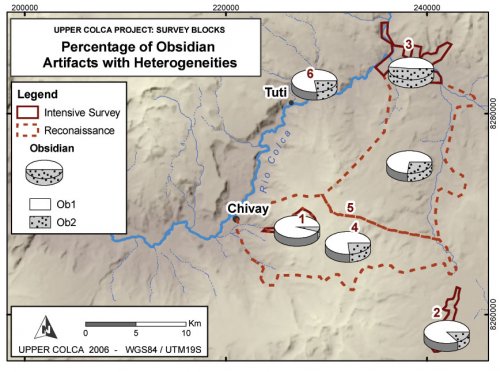(3) Block 1 had more homogeneous Ob1-type obsidian.
A further line of inquiry relates to the question of presence of heterogeneities in the obsidian. The Block 1 area with both the quarry pit, and the greatest abundance of large nodules, did not entirely consist of Ob1 homogenous obsidian. Investigating all the artifactual obsidian collected from surface contexts in the course of this project by survey block, a number of general patterns emerge.
Figure 6-3. Proportion of obsidian material as Ob1 and Ob2 (heterogeneities), by count.
|
Homogeneous: Ob1 |
Heterogeneous: Ob2 |
||||||
|
Block |
No. |
% |
m%Cortex |
No. |
% |
m % Cortex |
Total |
|
1 |
355 |
93.2 |
36.6 |
26 |
6.8 |
35.4 |
381 |
|
2 |
329 |
90.6 |
6.1 |
34 |
9.4 |
15.9 |
363 |
|
3 |
96 |
64.9 |
15.4 |
52 |
35.1 |
10.2 |
148 |
|
4 |
140 |
73.7 |
23.0 |
50 |
26.3 |
31.2 |
190 |
|
5 |
172 |
73.2 |
30.8 |
63 |
26.8 |
22.5 |
235 |
|
6 |
17 |
77.3 |
1.2 |
5 |
22.7 |
2.0 |
22 |
|
Total |
1109 |
82.8 |
22.6 |
230 |
17.2 |
21.7 |
1339 |
Table 6-8. Obsidian artifact material type by Survey Block surface collections.
Table 6-8 reveals that a small percentage of Ob2 material was actually found to have been used in Blocks 1 and 2, although the representation of Ob2 material was considerably higher in the other blocks in the survey. On the whole, Ob2 cores are decorticated to the same extent as Ob1 cores, although further upon exploration in Table 6-8) reveals that in Block 2 there appears to be a distinct preference for Ob1 obsidian as cores of this material have only 6% cortex while those of Ob2 have nearly 16% cortex. This is a pattern that might be expected, as the Ob2 obsidian has flaws that both negatively affect knapping quality and affect the visual appearance. However, the pattern is reversed in Blocks 3 and 5 where the Ob2 obsidian is decorticated to a greater extent than Ob1 material. There is a link between the color of the obsidian and the material quality because 45% of the grey obsidian is the Ob2 material, whereas for the other shades of obsidian the Ob2 ratios are smaller (10%-25%).
It was noted that in the Maymeja area of Block 1, unmodified obsidian nodules on the surface were often Ob2 material because they had small gas bubbles in them. Accordingly, it appears that some fraction of the obsidian that was knapped in the Maymeja area was made from this Ob2 surface material because it represented 6.8% of the collections from Block 1. The distribution of Ob1 and Ob2 material at the Chivay source will be further explored below prior to examining the results of the survey work in detail.

